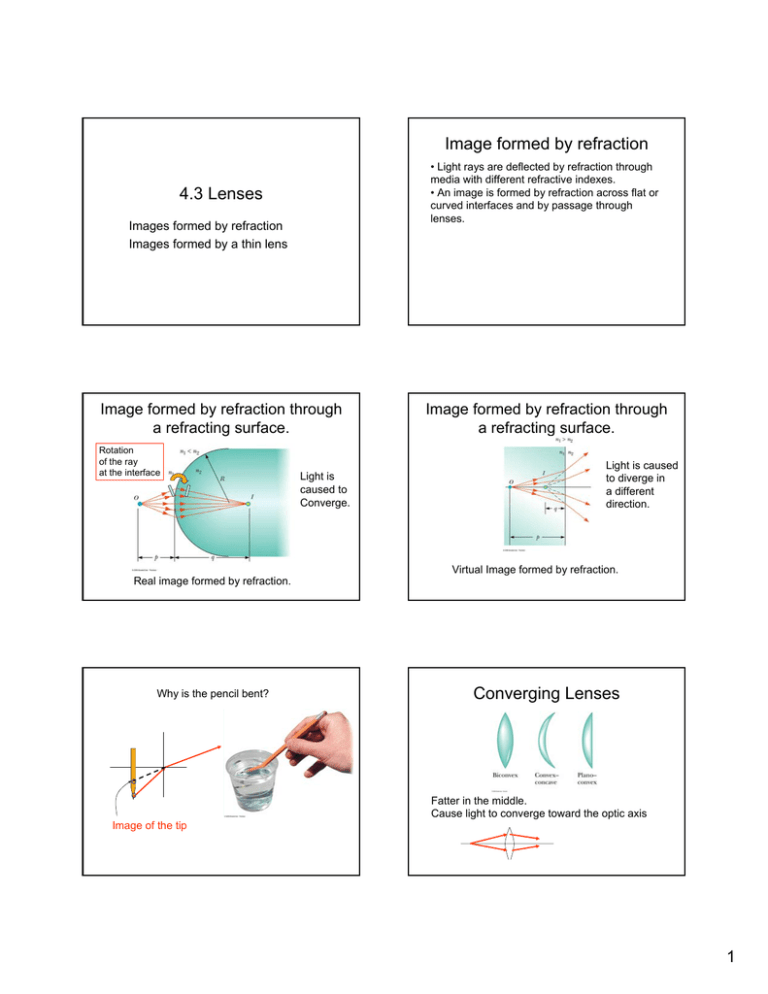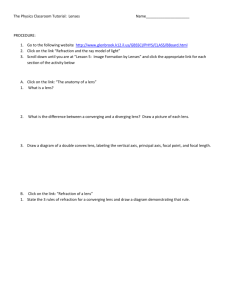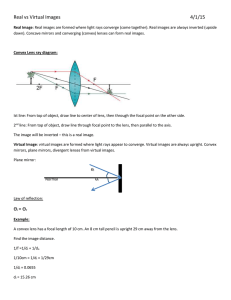Image formed by refraction 4.3 Lenses
advertisement

Image formed by refraction • Light rays are deflected by refraction through media with different refractive indexes. • An image is formed by refraction across flat or curved interfaces and by passage through lenses. 4.3 Lenses Images formed by refraction Images formed by a thin lens Image formed by refraction through a refracting surface. Rotation of the ray at the interface Light is caused to Converge. Image formed by refraction through a refracting surface. Light is caused to diverge in a different direction. Virtual Image formed by refraction. Real image formed by refraction. Why is the pencil bent? o o Converging Lenses Fatter in the middle. Cause light to converge toward the optic axis Image of the tip 1 Parallel light though a converging lens is focused at the focal point. Diverging Lenses Thinner in the middle Cause light to diverge away from the optic axis A real image is formed Ray diagram for a converging lenses Ray tracing for lenses • A line parallel to the lens axis passes through the focal point • A line through the center of the lens passes through undeflected. Image Object f Images formed by a converging lens converging light Real Inverted reduced converging light Question How will an object viewed through a converging lens appear as the lens is brought closer to the object? Real Inverted Enlarged diverging light Virtual Upright Enlarged At the focal point the image changes from real to virtual 2 Real Image Inverted Magnified Real Image Inverted Virtual image Upright Virtual Image Upright Magnified Parallel light though a diverging lens appears to go through the focal point. A virtual image is formed. Image formed by a diverging lens Virtual Upright Reduced 3 Question How will the image of an object formed by a diverging lens change as the lens is brought closer to the object? Virtual Image Upright Reduced Virtual image Upright Reduced Virtual image Upright Reduced Thin lens equation. 1 1 1 + = p q f p and q are positive if light passes through p is positive for real objects f is positive for converging lenses f is negative for diverging lenses q is positive for real images q is negative for virtual images. Magnification M=− h' q =− h p M positive- upright M negative- inverted for real image q is positive – image is inverted for virtual image q is negative – image is upright 4 Example Example An object is placed 30 cm in front of a converging lens with focal length 10 cm. Find the object distance and magnification. An object is placed 30 cm in front of a converging lens with focal length 10 cm. Find the object distance and magnification. Ray diagram. 1 1 1 + = p q f 1 1 1 = − q f p Real image q= fp (10)(30) = = 15cm p−f 30 − 10 M=− Example 35 mm 1.5 m 1 1 1 + = p q f f=10cm • 1 1 1 = − q f p M=− Inverted Reduced Projector lens An object is placed 30 cm in front of a diverging lens with a focal length of -10 cm. Find the image distance and magnification fp q= p−f q 15 =− = −0.5 p 30 F 10 cm ( −10)(30) = = −7.5cm 30 − ( −10) q −7.5 =− = 0.25 p 30 30 cm Virtual image Upright image reduced Suppose you want to project the image of a transparency 35 mm high on to a screen that is 1.5 m high using a lens with a focal length of 10 cm. Where would you position the film? How far from the lens would you place the screen? . Projector lens 35 mm 1.5 m f=10cm Find ratio of p and q. Use magnification Thin lens eq. h' q M= =− h p 1 1 1 + = p q f solve p = f ⎛⎜ 42.8 + 1 ⎞⎟ = 10 ⎛⎜ 43.8 ⎞⎟ = 10.23cm . ⎝ 42.8 ⎠ ⎝ 42.8 ⎠ h' 1.5 =− = −42.8 h 35x10−3 q = 42.8p 1 1 1 + = p 42.8p f just outside of f q = 42.8p = 42.8(10.23) = 438cm 5





